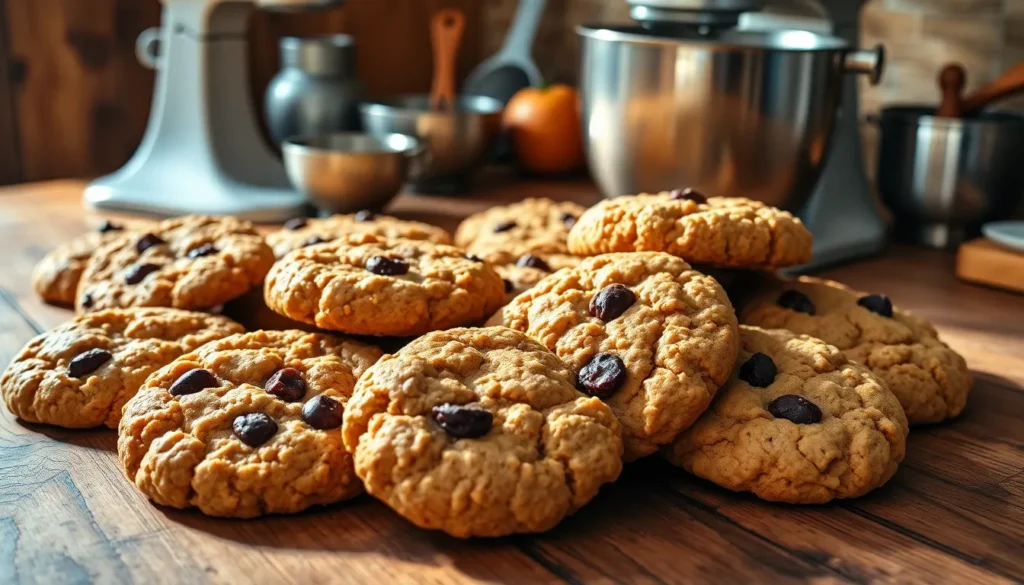Nothing beats the irresistible combination of tender oats, plump raisins, and that perfect chewy texture that makes oatmeal raisin cookies a timeless favorite. We’ve perfected this classic recipe to deliver cookies that stay soft and chewy for days while packed with wholesome oats and bursts of sweet raisins in every bite.
These aren’t your average oatmeal cookies – we’ve discovered the secret to achieving that coveted chewy center while maintaining just enough structure to hold together beautifully. The magic lies in our precise balance of brown sugar, the right flour-to-oat ratio, and a special mixing technique that creates the ideal texture.
Whether you’re baking for a family gathering or simply craving a nostalgic treat, these chewy oatmeal raisin cookies deliver comfort in every bite. They’re incredibly easy to make and use simple pantry staples you likely already have on hand.
Ingredients
Our carefully selected ingredients work together to create the perfect balance of chewiness and flavor in these beloved cookies. Each component plays a crucial role in achieving that ideal texture we all crave.
Dry Ingredients
- 1 cup all-purpose flour
- 1 teaspoon baking soda
- 1 teaspoon ground cinnamon
- 1/2 teaspoon nutmeg
- 1/2 teaspoon salt
- 3 cups old-fashioned rolled oats
Wet Ingredients
- 1 cup unsalted butter, softened to room temperature
- 1 cup packed light brown sugar
- 1/2 cup granulated sugar
- 2 large eggs, room temperature
- 2 teaspoons vanilla extract
Mix-ins
- 1 cup raisins
- 1/2 cup chopped walnuts (optional)
Equipment Needed
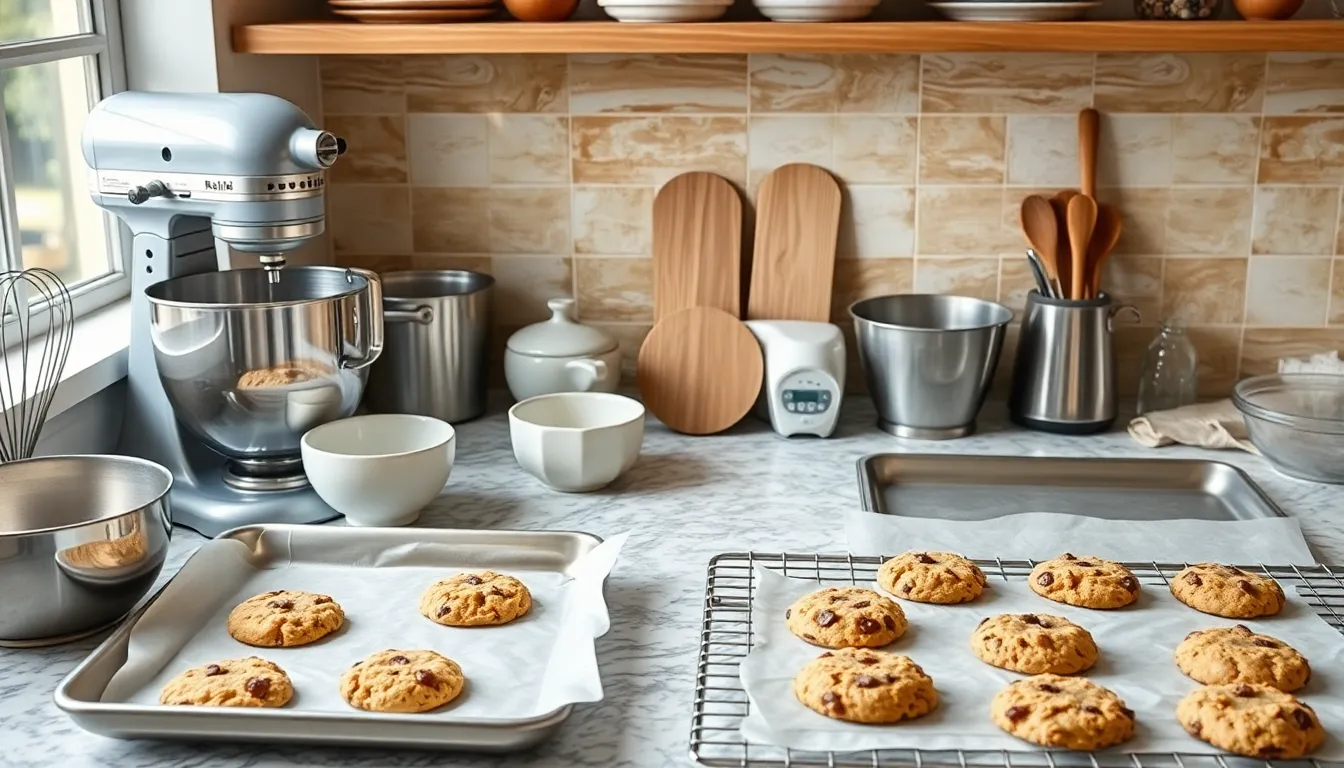
Creating these perfect chewy oatmeal raisin cookies requires the right tools to ensure consistent results every time. We’ve streamlined our equipment list to include only the essentials that make the biggest difference in your baking success.
Digital Scale or dry measuring cups and measuring spoons form the foundation of accurate baking. Precise measurements ensure our cookies achieve that ideal chewy texture we’re after.
Stand Mixer with paddle attachment delivers the best results for creaming butter and sugars to the perfect consistency. A large bowl with a hand mixer works as an excellent alternative if you don’t have a stand mixer available.
Medium Bowl serves as your workspace for whisking together all the dry ingredients before incorporating them into the wet mixture.
Small Bowl provides a convenient space for measuring smaller ingredients like vanilla extract or organizing your mix-ins.
Whisk ensures our dry ingredients blend evenly without overmixing the final dough.
Two Baking Sheets allow us to bake multiple batches efficiently while maintaining consistent oven temperature throughout the process.
Parchment Paper or silicone mat prevents sticking and promotes even browning on the bottom of each cookie. These surfaces also make cleanup effortless after your baking session.
Wire Rack becomes essential for proper cooling once our cookies emerge from the oven. Proper air circulation prevents soggy bottoms while preserving that coveted chewy center we’ve worked to achieve.
Instructions
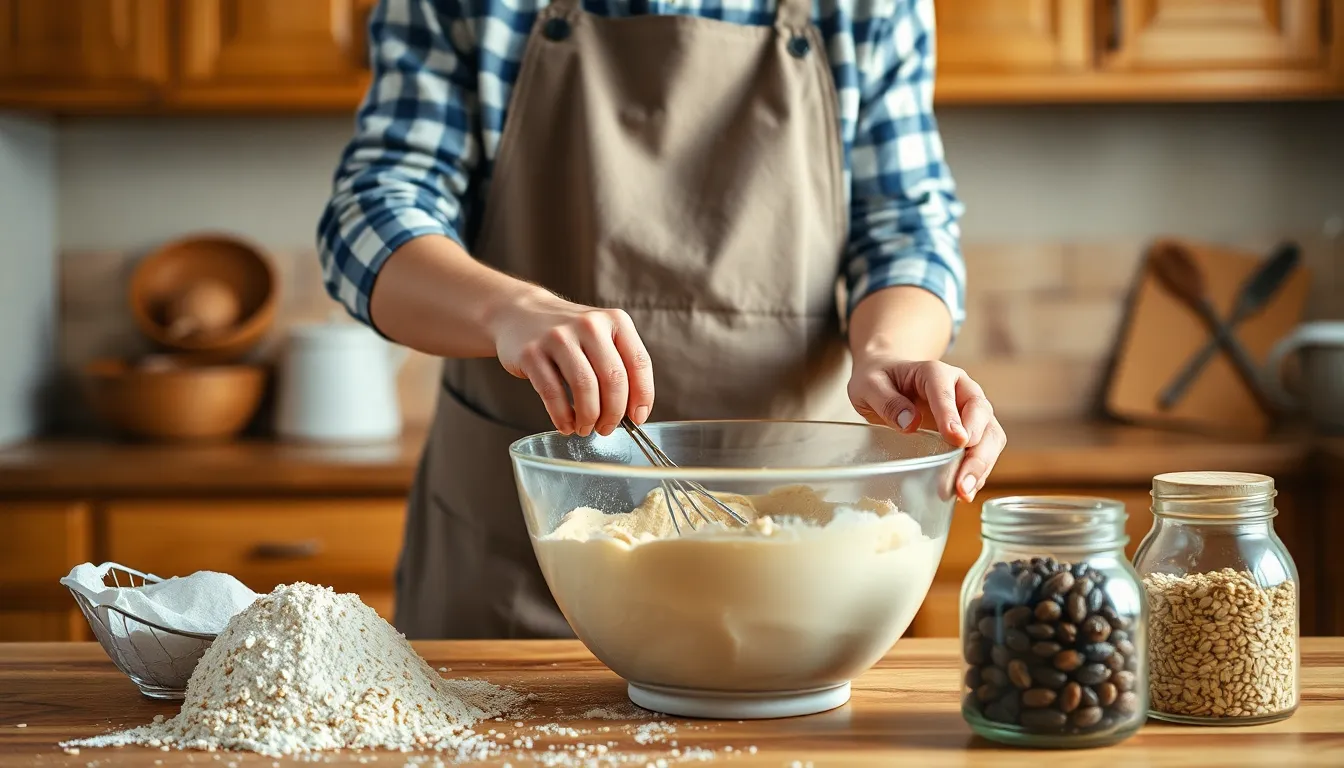
We’ll walk through each step to create perfectly chewy oatmeal raisin cookies that deliver on texture and flavor. Our method ensures consistent results every time.
Prep the Dough
Start by whisking together 2 cups all-purpose flour, 1 ½ cups old-fashioned rolled oats, 1 tablespoon ground cinnamon, 1 teaspoon salt, and ½ teaspoon baking soda in a medium bowl. Set this dry mixture aside.
In your stand mixer bowl, beat 1 cup softened unsalted butter with 1 cup packed brown sugar until the mixture becomes light and fluffy, about 3-4 minutes. Add 2 large eggs one at a time, beating well after each addition. Pour in 1 tablespoon vanilla extract and mix until smooth.
Gradually combine the dry ingredients with the wet mixture, mixing on low speed until just incorporated. Avoid overmixing to maintain our desired chewy texture. Fold in 2 cups raisins using a wooden spoon or spatula, distributing them evenly throughout the dough.
Chill the Dough
Cover the prepared dough tightly with plastic wrap and refrigerate for at least 30 minutes. This crucial step prevents excessive spreading during baking and helps our cookies maintain their thick, chewy shape. We recommend chilling for up to 2 hours for even better results.
Prepare for Baking
Preheat your oven to 350°F (175°C) while the dough finishes chilling. Line two baking sheets with parchment paper or silicone mats to ensure even browning and easy removal. Position your oven racks in the upper and lower thirds for optimal heat circulation.
Bake the Cookies
Scoop the chilled dough into portions of about 1.5 tablespoons each, rolling them into balls with your hands. Place the dough balls on your prepared baking sheets, spacing them about 2 inches apart to allow for spreading.
Bake for 10-13 minutes, rotating the baking sheets halfway through for even cooking. The cookies are ready when their edges appear lightly browned while the centers remain slightly underbaked and soft. They will continue cooking on the hot pan after removal.
Cool and Store
Allow the cookies to rest on the baking sheets for 5-10 minutes before transferring them to a wire rack. This initial cooling period helps them set properly without breaking apart.
Once completely cooled, store your chewy oatmeal raisin cookies in an airtight container at room temperature for up to one week. For longer storage, we can freeze the baked cookies for up to three months in freezer-safe containers or bags.
Tips for Extra Chewy Cookies

We’ve discovered that achieving the perfect chewy texture requires several strategic techniques that work together to create irresistibly soft cookies. Our approach focuses on ingredient ratios and baking methods that maximize moisture retention while preventing overcooking.
Refrigerate the dough for optimal results. We recommend chilling your cookie dough for up to 3 days before baking. This extended refrigeration period allows the ingredients to meld together completely and enhances the final chewiness of your cookies.
Master the underbaking technique for consistently chewy centers. Remove your cookies from the oven when they appear slightly underbaked in the center. The edges should look set while the middle remains soft and slightly pale. This approach ensures your cookies retain their chewy texture as they cool on the baking sheet.
Avoid overmixing your dough to prevent tough cookies. Mix ingredients just until they come together without developing the gluten in the flour. Overworked dough creates cookies with a dense rather than tender texture.
Choose cold butter instead of room temperature butter for your recipe. Cold butter helps maintain a thick consistency in your dough and contributes directly to the final chewy texture of your baked cookies.
Combine sugar types strategically for maximum chewiness. We use both light brown sugar and granulated sugar in our recipe because the brown sugar adds moisture while the granulated sugar provides structure. This combination creates the ideal balance for chewy cookies.
| Technique | Timing | Result |
|---|---|---|
| Dough refrigeration | Up to 3 days | Enhanced chewiness |
| Baking time | 11-13 minutes at 350°F | Slightly underbaked centers |
| Cooling time | 2-3 minutes on baking sheet | Maintained softness |
Space cookies properly on your baking sheets with about 2 inches between each portion. Proper spacing prevents cookies from spreading into each other while allowing even heat circulation for consistent texture throughout each batch.
Storage Instructions

Proper storage ensures our chewy oatmeal raisin cookies maintain their delicious texture and flavor for days or even months. We’ll walk you through the best methods to keep these treats fresh and ready to enjoy.
Short-Term Storage Options
Room temperature storage works perfectly for immediate consumption. We recommend placing completely cooled cookies in an airtight container where they’ll stay fresh for up to 3 to 4 days. This method preserves their chewy texture without any additional preparation.
Refrigeration extends the freshness window significantly. Store our cookies in an airtight container in the refrigerator for up to one week. We suggest layering cookies with parchment paper to prevent them from sticking together during storage.
Long-Term Storage Answers
Freezing baked cookies provides the longest storage option. Place completely cooled cookies in a zip-top freezer bag and freeze for up to three months. Thaw them in the refrigerator overnight before serving to restore their original texture.
Freezing unbaked dough offers incredible convenience for fresh cookies anytime. Form the dough into balls and freeze them on a parchment-lined baking sheet. Transfer the frozen dough balls to a zippered freezer bag where they’ll keep for up to one month. Bake directly from frozen and add a few extra minutes to the original baking time.
Essential Storage Tips
Cooling completely on a wire rack before storage prevents moisture buildup that can make cookies soggy. We always wait until cookies reach room temperature before transferring them to storage containers.
Airtight containers are crucial for maintaining freshness and preventing condensation from affecting texture. Choose containers that seal properly to lock in the cookies’ chewy goodness and protect them from absorbing other flavors.
| Storage Method | Duration | Container Type |
|---|---|---|
| Room Temperature | 3-4 days | Airtight container |
| Refrigerated | Up to 1 week | Airtight container with parchment layers |
| Frozen (baked) | Up to 3 months | Zip-top freezer bag |
| Frozen (unbaked dough) | Up to 1 month | Zippered freezer bag |
Make-Ahead Tips
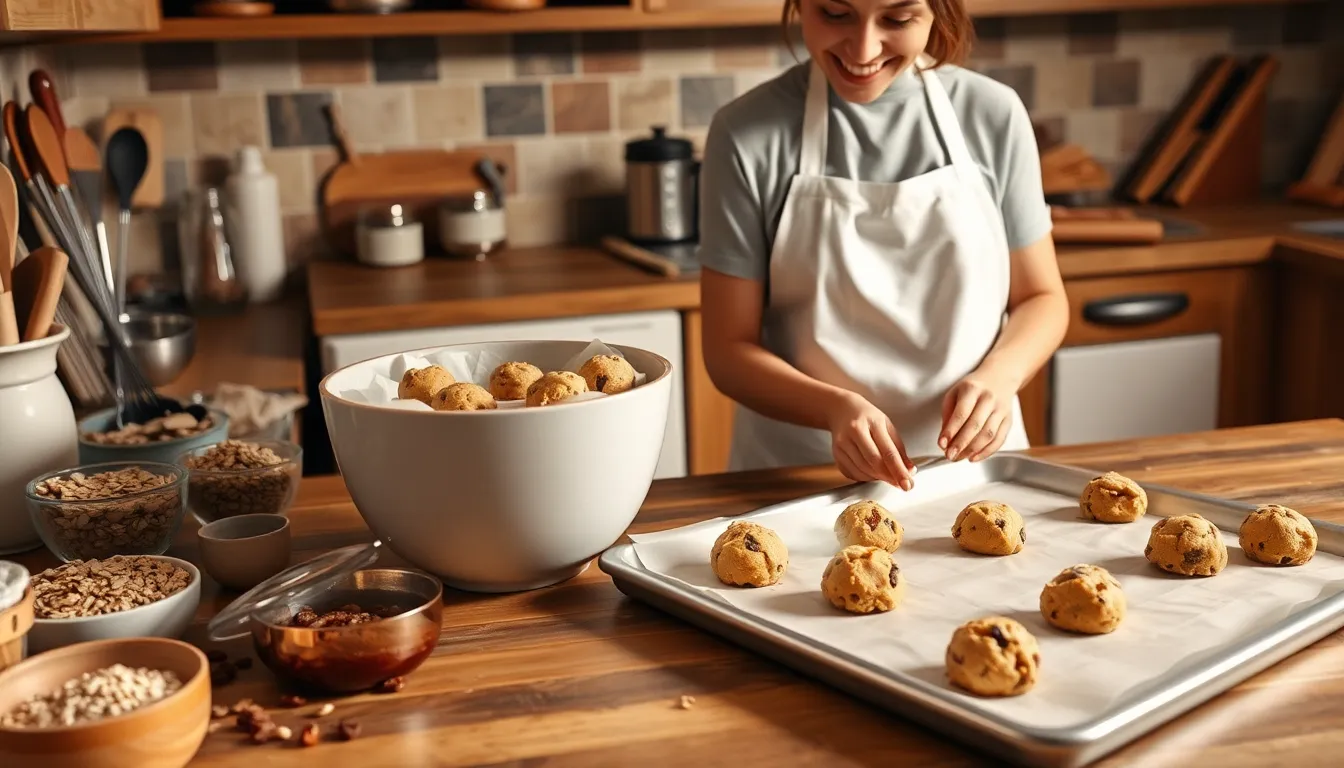
We love how these chewy oatmeal raisin cookies can be prepared well in advance to save time during busy baking days. The cookie dough stores beautifully and actually improves in texture when given time to rest.
Preparing Cookie Dough in Advance
Our cookie dough can be refrigerated for up to 3 days before baking. This extended chilling time allows the oats to absorb moisture from the wet ingredients while developing deeper flavors. We recommend covering the dough tightly with plastic wrap or storing it in an airtight container to prevent it from drying out.
For longer storage we can freeze the prepared dough for up to one month. Simply wrap the dough ball tightly in plastic wrap and place it inside a freezer-safe bag. When ready to bake we thaw the dough in the refrigerator overnight before proceeding with rolling and baking.
Individual Cookie Portions
We find it convenient to portion the dough into individual cookie balls before storing. After the initial 30-minute chill time we roll the dough into balls and place them on a parchment-lined baking sheet. These portioned cookies can be frozen solid then transferred to a freezer bag for up to one month.
Baking from frozen requires no thawing time. We simply add 1 to 2 extra minutes to the original baking time and watch for the edges to become lightly golden.
Resting Benefits
| Resting Time | Benefits |
|---|---|
| 20-30 minutes | Helps maintain cookie shape during baking |
| 30 minutes minimum | Allows oats to absorb moisture preventing excessive spreading |
| Up to 3 days | Develops deeper flavors and improves texture |
The resting period of 20 to 30 minutes before rolling into balls helps our cookies maintain their shape during baking. This technique prevents the cookies from spreading too thin and ensures we achieve that perfect chewy texture we’re after.
Troubleshooting Common Issues
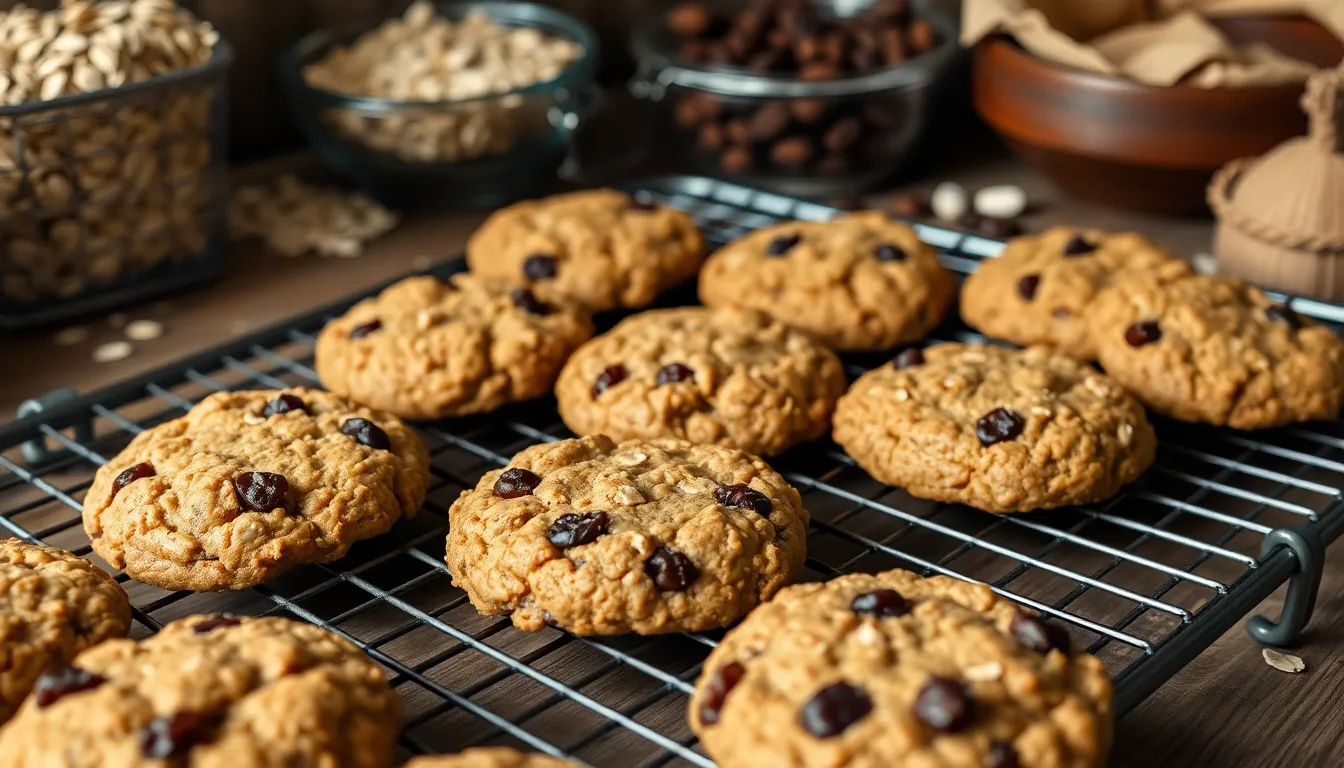
Even with our perfected recipe, we occasionally encounter challenges when baking chewy oatmeal raisin cookies. Understanding these common problems and their answers helps us achieve consistently delicious results every time.
Cookies Too Dry or Crumbly
When our cookies turn out dry or fall apart easily, overbaking is usually the culprit. We need to check our oven temperature accuracy since many ovens run hot. Reducing the baking time by 1 to 2 minutes often solves this issue. Insufficient moisture in the dough can also cause dryness, so we might need to add slightly more butter or liquid ingredients next time.
Cookies Not Spreading Properly
Cookies that maintain their mounded shape typically result from incorrect flour measurement or overly cold dough. We should measure flour by spooning it into our measuring cup and leveling it off rather than scooping directly from the bag. Our dough should only chill for 30 minutes maximum before baking to prevent this spreading issue.
Cookies Too Soft or Underbaked
Sometimes our cookies feel too soft even after cooling completely. This happens when we remove them from the oven before the edges turn lightly golden brown. We should bake until the edges show color and the tops appear set, even if the centers look slightly underdone.
Sticky Dough Handling
Our cookie dough naturally feels sticky due to its moisture content, which creates the desired chewy texture. Rather than adding more flour, we chill the dough for about 30 minutes to make it more manageable for shaping and baking.
Overmixing Problems
Tough cookies often result from overmixing our dough after adding the flour. We should mix ingredients just until they combine to maintain the tender, chewy texture we want.
| Issue | Primary Cause | Solution | Prevention |
|---|---|---|---|
| Dry/Crumbly | Overbaking | Reduce baking time 1-2 minutes | Check oven temperature |
| No Spreading | Cold dough | Limit chilling to 30 minutes | Proper flour measurement |
| Too Soft | Underbaking | Bake until edges brown | Watch for set tops |
| Sticky Dough | Normal moisture | Chill 30 minutes | Don’t add extra flour |
| Tough Texture | Overmixing | Mix just until combined | Stop when flour disappears |
Achieving Perfect Chewiness
We enhance our cookies’ chewiness by incorporating molasses, which adds moisture and deepens the flavor profile. Proper dough chilling allows the oats to absorb moisture without making the cookies dense. Our cookies might appear slightly underbaked when we remove them from the oven, but they continue setting as they cool on the baking sheet.
Variations and Substitutions
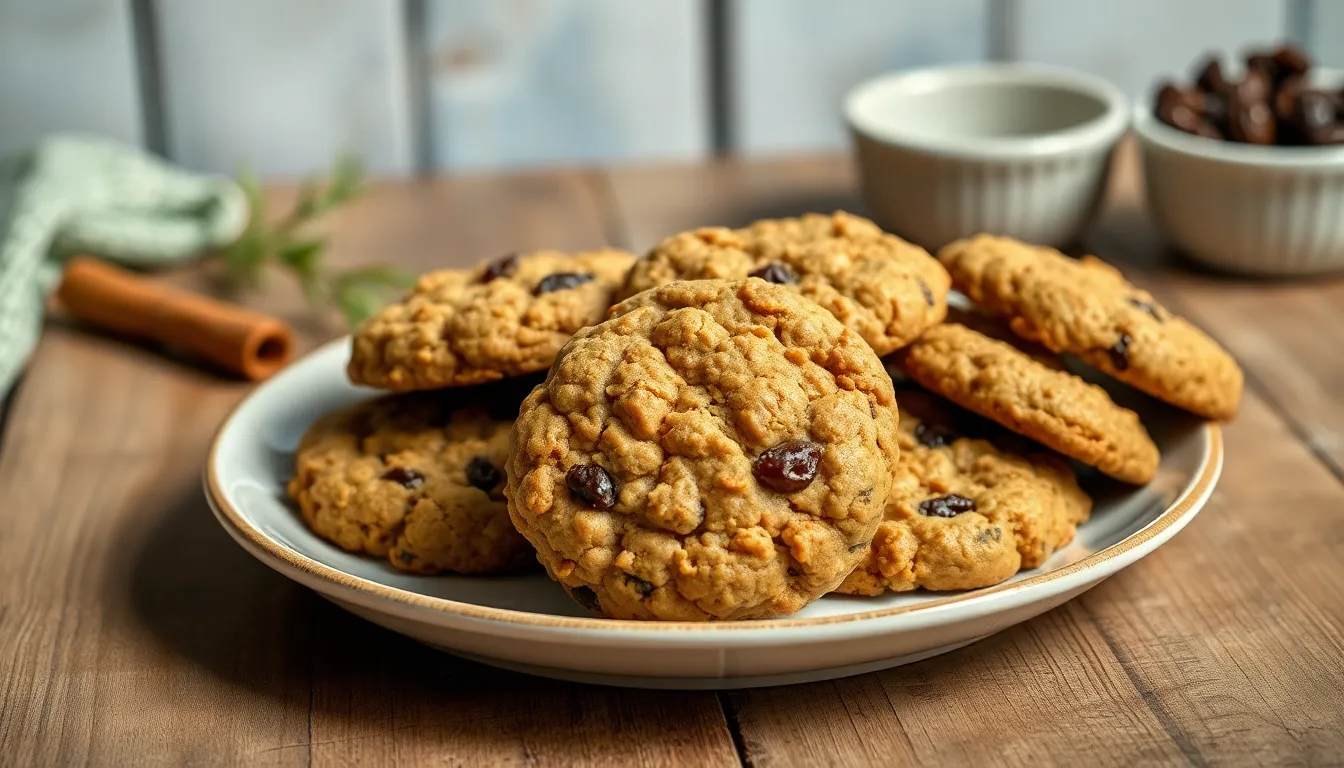
We love how versatile our chewy oatmeal raisin cookies can be with simple ingredient swaps and creative additions. These modifications allow us to customize the recipe to suit different tastes and dietary preferences while maintaining that signature chewy texture we’ve perfected.
Spice Variations
Cinnamon remains our go-to spice for classic oatmeal raisin cookies. But, we often experiment with other warming spices to create unique flavor profiles. Nutmeg adds a subtle warmth that complements the oats beautifully. Fresh ginger brings a gentle heat that pairs wonderfully with the sweetness of raisins. We recommend starting with 1/4 teaspoon of these alternative spices and adjusting to taste.
Creative Add-Ins
Our base recipe welcomes many mix-ins that transform these cookies into exciting variations. Chocolate chips create a delightful contrast to the chewy oats and provide bursts of sweetness. Chopped walnuts or pecans contribute a satisfying crunch and nutty flavor that elevates the entire cookie experience. Dried cranberries offer a tart sweetness that balances the rich molasses notes perfectly.
Flavor Enhancer Substitutions
Molasses delivers that distinctive rich and bold flavor we love in our cookies. When molasses isn’t available, we successfully substitute it with honey for a floral sweetness. Maple syrup provides a subtle caramel note that works beautifully with the oats. Dark corn syrup maintains the moisture content while adding depth. Golden syrup offers a buttery sweetness that creates an equally delicious cookie.
Raisin Alternatives
Traditional raisins can be easily replaced with other dried fruits to create new flavor combinations. Dried cranberries provide a tart bite that brightens the overall taste profile. Golden raisins offer a milder, sweeter flavor than regular raisins. When we omit raisins entirely, we simply get perfectly chewy oatmeal cookies that stand beautifully on their own.
Sugar Modifications
Brown sugar contributes significantly to our cookies’ signature chewiness through its molasses content and moisture retention properties. We can adjust the ratio between brown sugar and granulated sugar to fine-tune texture. More brown sugar increases chewiness, while additional granulated sugar creates a slightly crispier edge.
Essential Substitution Tips
| Substitution Type | Original Ingredient | Alternative Options | Notes |
|---|---|---|---|
| Raisins | Regular raisins | Dried cranberries, golden raisins | Same quantity measurement |
| Molasses | Molasses | Honey, maple syrup, dark corn syrup, golden syrup | Equal amounts for substitution |
| Oats | Old-fashioned oats | Quick oats (not recommended) | Old-fashioned oats provide better texture |
Using old-fashioned oats remains crucial for achieving optimal texture in our cookies. Quick oats break down too much during baking and don’t provide the hearty chew we’re after. Room temperature eggs and properly softened butter ensure our dough comes together perfectly and contributes to that ideal chewy consistency. Avoiding overbaking becomes even more important when we make substitutions, as different ingredients may affect baking times slightly.
Conclusion
These chewy oatmeal raisin cookies represent the perfect balance of texture and flavor that we’ve all been searching for. With our proven techniques and carefully tested ratios you’ll consistently create cookies that are soft in the center with just the right amount of chew.
The beauty of this recipe lies in its reliability and flexibility. Whether you’re making them fresh for tonight’s dessert or preparing dough ahead for busy weekdays our method ensures delicious results every time.
We’re confident that once you try these cookies they’ll become your go-to recipe for satisfying that homemade cookie craving. The combination of tender oats plump raisins and that irresistible chewy texture makes them impossible to resist – and that’s exactly how we like our cookies.
Frequently Asked Questions
What makes these oatmeal raisin cookies extra chewy?
The key to achieving extra chewy cookies lies in strategic techniques: refrigerate the dough for up to 3 days to improve texture, use a combination of brown sugar and granulated sugar for optimal moisture retention, and master the underbaking technique by removing cookies when they appear slightly underbaked in the center. Using cold butter and avoiding overmixing also contributes to the perfect chewy consistency.
How long can I store oatmeal raisin cookies?
For short-term storage, keep completely cooled cookies in an airtight container at room temperature for 3-4 days or refrigerated for up to one week. For long-term storage, freeze baked cookies in zip-top freezer bags for up to 3 months. Always layer cookies with parchment paper to prevent sticking and ensure containers are airtight to maintain freshness.
Can I make the cookie dough ahead of time?
Yes! Cookie dough can be refrigerated for up to 3 days or frozen for up to 1 month. Refrigerating allows oats to absorb moisture and develop deeper flavors. For convenience, portion dough into individual cookie balls before freezing, then bake directly from frozen with minimal adjustments to baking time.
Why are my oatmeal raisin cookies too dry or crumbly?
Dry, crumbly cookies typically result from overbaking or incorrect flour measurements. Remove cookies from the oven when they appear slightly underbaked in the center—they’ll continue cooking on the hot pan. Use a kitchen scale for accurate flour measurements, and ensure you’re not packing flour too tightly when using measuring cups.
What equipment do I need to make perfect oatmeal raisin cookies?
Essential equipment includes: digital scale or measuring cups/spoons for accuracy, stand mixer with paddle attachment for creaming, mixing bowls, whisk for dry ingredients, two baking sheets for efficiency, parchment paper or silicone mats to prevent sticking, and a wire rack for proper cooling to maintain the cookies’ chewy texture.
Can I substitute ingredients in this oatmeal raisin cookie recipe?
Absolutely! You can swap raisins for dried cranberries or chocolate chips, add nuts like walnuts or pecans, and experiment with spices like nutmeg or fresh ginger. For molasses substitutes, use honey or maple syrup. Always use old-fashioned oats rather than quick oats to maintain proper texture and chewiness.
How do I prevent my cookies from spreading too much during baking?
To prevent excessive spreading, chill your dough for at least 30 minutes before baking. Use cold butter in your recipe, avoid overmixing the dough, and ensure proper spacing between cookies on the baking sheet. Also, make sure your baking sheets aren’t too warm when placing the dough on them.
What’s the secret to getting plump, flavorful raisins in my cookies?
For the best results, use fresh, plump raisins and consider soaking them briefly in warm water before adding to the dough—just pat them dry first. This helps prevent them from drawing moisture from the cookie dough during baking, keeping both the raisins tender and the cookies perfectly chewy.

